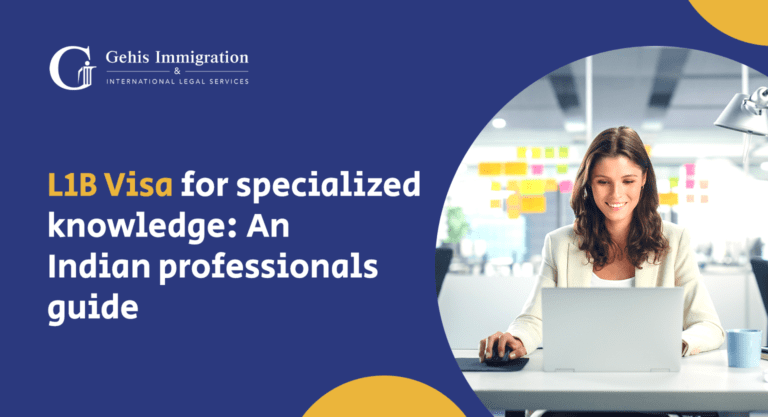The L1B visa is a valuable opportunity for Indian professionals seeking to work in the United States. It is a non-immigrant visa category that allows multinational companies to transfer employees with specialized knowledge to their U.S. offices. This visa is significant for Indian professionals looking to enhance their careers and gain international experience.
The L1B visa serves as a bridge between multinational companies and their skilled employees. It enables Indian professionals to contribute their specialized knowledge to the U.S. operations of their employers, fostering innovation, growth, and collaboration between different branches and affiliates. By facilitating the transfer of talented individuals, the L1B visa promotes the exchange of expertise and ideas across borders.
Indian professionals, renowned for their skills and expertise in various fields, can leverage the L1B visa. Whether working on cutting-edge technologies, engaging with diverse teams, or gaining exposure to global markets, the L1B visa opens doors to many possibilities.
The L1B visa holds immense importance for Indian professionals as it offers a career growth and advancement platform. Professionals can enhance their skills, broaden their perspectives, and develop a global mindset by working in the United States. The experience gained through the L1B visa can prove invaluable, contributing to personal and professional development and paving the way for future success.
What is the eligibility for the L1B visa for Specialized Knowledge?
The L1B visa is a non-immigrant visa category specifically designed for employees with specialized knowledge transferred from a foreign office to a U.S. branch, subsidiary, or affiliate of the same employer. Let’s delve into the key aspects of understanding the L1B visa.
To be eligible for the L1B visa, individuals must meet the following criteria:
Employment: The employee must have been employed by the same employer or a qualifying organization for at least one continuous year within the previous three years. The employment must have been in an executive, managerial, or specialized knowledge capacity.
Specialized knowledge: The employee must possess specialized knowledge vital to the employer’s U.S. operations. This specialized knowledge could involve advanced expertise in the company’s products, services, research, systems, or procedures. The employee’s knowledge should be uncommon and not easily obtainable in the U.S. labor market.
Qualifying relationship: The foreign employer and the U.S. company must have a qualifying relationship. This relationship can include being a parent company, subsidiary, branch, or affiliate. Both foreign and U.S. entities must continue to engage in regular, legitimate business operations.
What are the Duration and limitations of the L1B visa For Specialized Knowledge?
The initial period of stay granted with an L1B visa is up to three years. Extensions may be granted in increments of up to two years, with a maximum stay of five years. However, it’s important to note that the L1B visa is non-immigrant and does not provide a direct path to permanent residency (Green Card) status. Nevertheless, it allows individuals to work temporarily in the United States while retaining ties to their home country.
What are the differences between L1A and L1B visas?
The L1 visa category also includes the L1A visa, designed for managers and executives. Here are some key differences between the L1A and L1B visas:
Role and responsibility: L1A visa holders are managers or executives with significant decision-making authority, while L1B visa holders are employees with specialized knowledge.
Eligibility requirements: L1A visa applicants must demonstrate their managerial or executive role, whereas L1B visa applicants must prove their specialized knowledge.
Stay duration: L1A visa holders may initially stay for up to three years, with extensions of up to seven years. L1B visa holders may initially stay for up to three years, with extensions of up to five years.
Path to permanent residency: L1A visa holders can apply for permanent residency through the EB-1C immigrant visa category, while L1B visa holders may need to explore alternative paths for obtaining a Green Card.
What is Specialized Knowledge for an L1B visa?
Specialized knowledge plays a crucial role in the context of L1B visas. It is the key qualification distinguishing L1B visa holders from other categories of employees. Let’s explore the definition of specialized knowledge and its significance in the L1B visa application process.
Defining specialized knowledge in the context of L1B visas
In the context of L1B visas, specialized knowledge refers to an employee’s unique and advanced expertise in a specific area critical to the employer’s operations. This knowledge can be related to the company’s products, services, processes, techniques, management, or any other aspect that sets employees apart and makes their skills indispensable.
Specialized knowledge goes beyond general knowledge or skills that can be easily acquired or replicated. It involves a deeper understanding, experience, and expertise not commonly found in the U.S. labor market. The employee’s specialized knowledge should be essential to the employer’s U.S. operations and contribute significantly to the company’s competitiveness, growth, or efficiency.
How to demonstrate specialized knowledge in the L1B application process?
When applying for an L1B visa, it is essential to provide evidence demonstrating the employee’s specialized knowledge. This evidence helps substantiate the claim that the employee possesses unique expertise vital to the employer’s U.S. operations. Here are some ways to demonstrate specialized knowledge:
Job description: Clearly describe the employee’s role and responsibilities, highlighting the specialized nature of their knowledge. Emphasize the specific skills, experience, and qualifications required for the position.
Documentation: Gather documentation that supports the employee’s specialized knowledge, such as certificates, training records, patents, publications, awards, or any other relevant evidence that showcases their expertise.
Comparative analysis: Compare the employee’s skills and knowledge to those of others in similar positions in the industry. Highlight how the employee’s specialized knowledge sets them apart and is not readily available in the U.S. labor market.
Letters of support: Obtain letters from supervisors, colleagues, or clients that attest to the employee’s specialized knowledge and the value they bring to the organization. These letters can provide specific examples or testimonials about the employee’s expertise and its significance in the company’s operations.
It is important to compile a comprehensive and persuasive case demonstrating the employee’s specialized knowledge and its importance to the employer. Consulting with an immigration attorney or qualified consultants can help navigate the documentation requirements and ensure that the application effectively showcases the employee’s unique expertise. By establishing and demonstrating specialized knowledge, applicants can strengthen their L1B visa applications and increase the chances of approval, enabling them to transfer their valuable skills to the U.S. operations of their employer.
What are the benefits of the L1B Visa for Indian Professionals?
The L1B visa offers numerous advantages for Indian professionals seeking to work in the United States. Here are some key benefits that make the L1B visa an attractive option:
Skill enhancement:
Working in the United States under the L1B visa allows Indian professionals to enhance their skills and knowledge by gaining exposure to advanced technologies, industry trends, and best practices. This exposure can significantly contribute to their professional growth and make them more competitive in the global job market.
Leadership roles:
L1B visa holders, as employees with specialized knowledge, may be able to take on leadership roles within their U.S. companies. This can include managing teams, overseeing projects, making important business decisions, providing valuable experience, and strengthening their credentials.
Cultural exchange:
Working in a different cultural environment provides Indian professionals with a unique opportunity to broaden their horizons, gain a global perspective, and develop a deeper understanding of diverse cultures and work practices.
Collaboration and networking:
L1B visa holders can collaborate with professionals from different backgrounds, fostering cross-cultural understanding and expanding their professional networks. Building relationships with colleagues, clients, and industry contacts in the United States can open doors to new opportunities and partnerships.
Market exposure:
Working in the United States exposes Indian professionals to one of the world’s largest and most dynamic markets. This exposure can provide insights into new business strategies, customer preferences, and industry trends, enhancing their market knowledge and positioning them for future success.
Dual intent visa:
The L1B visa is considered a dual intent visa, allowing Indian professionals to demonstrate an intent to reside temporarily in the United States while also having the option to pursue a permanent residency (Green Card). This flexibility provides a potential pathway for long-term settlement in the United States.
Employment-based Green Card:
L1B visa holders may be eligible to transition to permanent residency through employment-based categories, such as the EB-1C immigrant visa for multinational executives or managers. By meeting the requirements and following the appropriate procedures, L1B visa holders can explore the possibility of obtaining a Green Card and enjoying the benefits of permanent residency in the United States.
It’s important to note that each individual’s circumstances and immigration policies may vary, so it’s recommended to consult with an immigration attorney or qualified professional to understand the specific benefits and options available based on personal situations.
What is the application process for the L1B Visa?
The application process for the L1B visa involves several steps, from gathering the necessary documentation to filing the petition and responding to Requests for Evidence (RFE). Let’s explore these steps in detail:
Employer’s documentation:
The employer must gather and submit documentation supporting the L1B visa petition. This includes information about the qualifying relationship between the U.S. and foreign companies, such as organizational charts, annual reports, and financial statements.
Employee’s documentation:
The employee must provide evidence to establish their eligibility for the L1B visa. This may include educational certificates, employment letters, resumes, performance evaluations, and other documentation demonstrating their specialized knowledge and qualifications.
Business documentation:
Additional supporting documentation may be required to show the nature of the employer’s business, its operations, and the need for the employee’s specialized knowledge in the United States. This can include client contracts, project descriptions, technical documentation, or other relevant materials.
Form I-129:
The employer must file Form I-129, Petition for a Nonimmigrant Worker with U.S. Citizenship and Immigration Services (USCIS). This form is the official petition requesting the employee’s classification as an L1B visa holder. The form must be completed accurately, and the appropriate filing fees must be paid.
Supporting materials:
Along with Form I-129, the employer must submit all the supporting documentation demonstrating the employee’s eligibility for the L1B visa. This includes the employer’s and employee’s documentation and any additional materials that provide evidence of their specialized knowledge and the need for their transfer to the United States.
RFE issuance:
After reviewing the petition and supporting materials, USCIS may issue a Request for Evidence (RFE) if they require further information or clarification. The RFE will specify the additional evidence or documentation needed to support the L1B visa application.
RFE response:
In coordination with the employee and their legal representative, the employer must prepare a comprehensive response to the RFE. This response should address the specific requests, provide the requested evidence, and address any concerns raised by USCIS. Submitting a well-documented and persuasive response within the specified timeframe is essential.
USCIS decision:
After reviewing the response to the RFE, USCIS will decide on the L1B visa application. If approved, USCIS will issue an Approval Notice, and the employee can proceed with the consular processing or, if eligible, apply for a change of status within the United States.
It is crucial to carefully follow the USCIS guidelines, adhere to the required timelines, and ensure the accuracy and completeness of all documentation during the application process. Working with an experienced immigration attorney or qualified professional can guide and assist in navigating the application process and responding to any challenges.
What Are The Challenges and Common Issues in the L1B Visa Application Process?
The L1B visa application process can sometimes present challenges or encounter common issues. Here are some key considerations for addressing these challenges and seeking assistance:
Meeting eligibility criteria:
Ensure that the employee meets the eligibility criteria for the L1B visa, including having the required specialized knowledge and a qualifying relationship between the U.S. and foreign employer. Carefully review the documentation to demonstrate the employee’s qualifications and the necessity of their transfer.
Documentation accuracy and completeness:
Thoroughly gather and review all required documentation to ensure accuracy and completeness. Double-check that the supporting materials effectively demonstrate the employee’s specialized knowledge and the employer’s need for their transfer to the United States.
Timing and processing delays:
The L1B visa application process can sometimes experience delays due to high volumes of applications or administrative backlogs. It is important to submit the application well in advance and allow sufficient time for processing. Track the progress of the application and follow up with USCIS as necessary.
Understand the request:
Carefully review the Request for Evidence (RFE) to understand the specific information or documentation USCIS seeks. Ensure the response addresses each point raised in the RFE comprehensively and well-documented.
Thorough response preparation:
Work closely with an immigration attorney or qualified professional to prepare a strong and persuasive response to the RFE. Gather the requested evidence, provide detailed explanations, and address any concerns USCIS raises. Present a clear and compelling case to support the L1B visa application.
Timely response submission:
Adhere to the deadline specified in the RFE for submitting the response. Prepare the response well in advance for a thorough review and timely submission. Late or incomplete responses may result in denying the L1B visa application.
Consult with an immigration attorney: Engage the services of an experienced immigration attorney specializing in employment-based visas, specifically the L1B visa. They can provide expert advice, assess your situation, guide you through the application process, and help you overcome challenges.
Professional documentation review:
Have an immigration attorney or qualified professional review all documentation before submission. Their expertise can ensure that the application package is complete, accurate, and effectively presents the employee’s specialized knowledge and the employer’s need for their transfer.
Stay updated on immigration policies:
Immigration policies and procedures can change over time. Stay informed about any updates or changes in L1B visa regulations to ensure compliance and optimize your application strategy.
Remember, seeking legal assistance can greatly enhance your chances of a successful L1B visa application by navigating potential challenges and ensuring all requirements are met. An experienced immigration attorney can provide personalized guidance tailored to your specific circumstances and help you overcome any obstacles that may arise along the way.
What Are The Tips and Strategies for a Successful L1B Visa Application
Successfully obtaining an L1B visa requires careful preparation and attention to detail. Here are some tips and strategies to help you maximize your chances of a successful application:
Preparing a strong case for specialized knowledge
Document specialized knowledge: Gather and organize all relevant documents demonstrating the employee’s specialized knowledge. This can include degrees, certifications, training records, patents, publications, or other evidence showcasing their expertise in a specific field or industry.
Provide detailed job descriptions: Clearly articulate the employee’s role and responsibilities, highlighting the specialized nature of their work and the specific knowledge they possess that is essential to the employer’s operations.
Quantify accomplishments: Whenever possible, provide quantitative data or examples of how the employee’s specialized knowledge has positively impacted the company, such as increased productivity, cost savings, or successful project outcomes.
Understanding the role of the employer in the application process
Collaborate with the employer: Work closely with the employer to gather all the information and documentation required for the L1B visa application. Ensure they understand their responsibilities in providing supporting materials and proactively seek cooperation.
Demonstrate the employer’s need for specialized knowledge: Clearly explain how the employee’s is critical to the employer’s U.S. operations and how their presence will benefit the company’s growth, competitiveness, or innovation.
Presenting a comprehensive and well-organized application
Follow application instructions:
Review the USCIS guidelines and instructions for the L1B visa application. To ensure compliance, adhere to the specified format, document requirements, and filing procedures.
Create a detailed petition letter:
Craft a compelling and comprehensive petition letter that provides a clear overview of the application, highlights the employee’s specialized knowledge, and explains how their transfer will benefit the U.S. operations of the employer.
Organize supporting documents:
Arrange all supporting documents in a logical and easily accessible manner. Use tabs, dividers, or a table of contents to make it easier for the immigration officer to locate specific documents.
Proofread and review:
Thoroughly review all application materials for accuracy, consistency, and completeness. Proofread all written documents, ensuring they are free from errors or typos.
Seek professional guidance
Consult with an immigration attorney: Consider working with an experienced immigration attorney specializing in employment-based visas, such as the L1B visa. They can provide expert advice, review your application, and guide you to ensure all requirements are met.
Utilize immigration resources: Stay informed about the latest updates and resources related to the L1B visa application process. Consult official USCIS websites, attend informational webinars, or engage with online communities to gather valuable insights and information.






